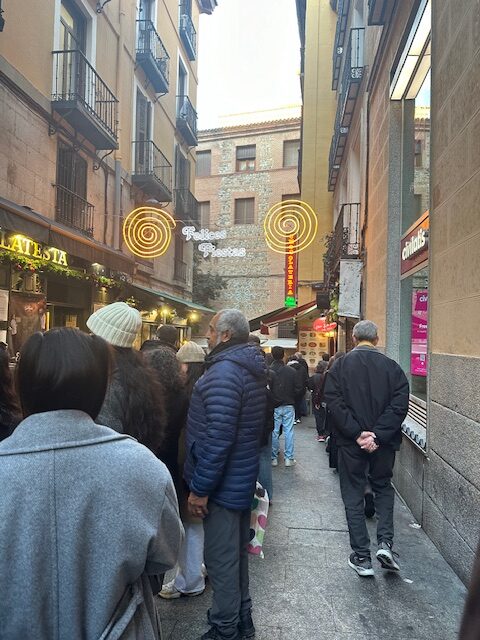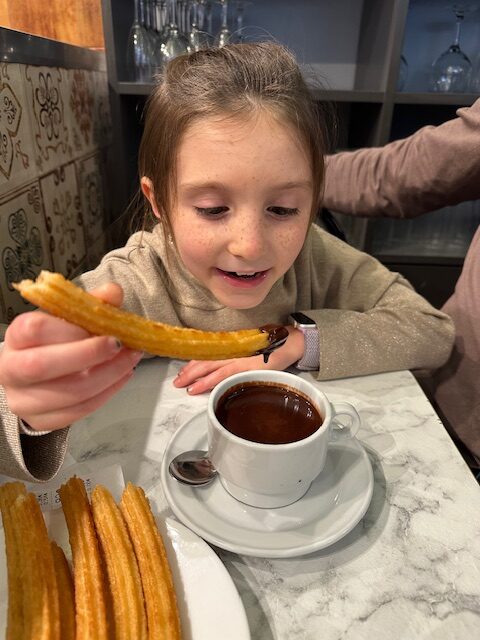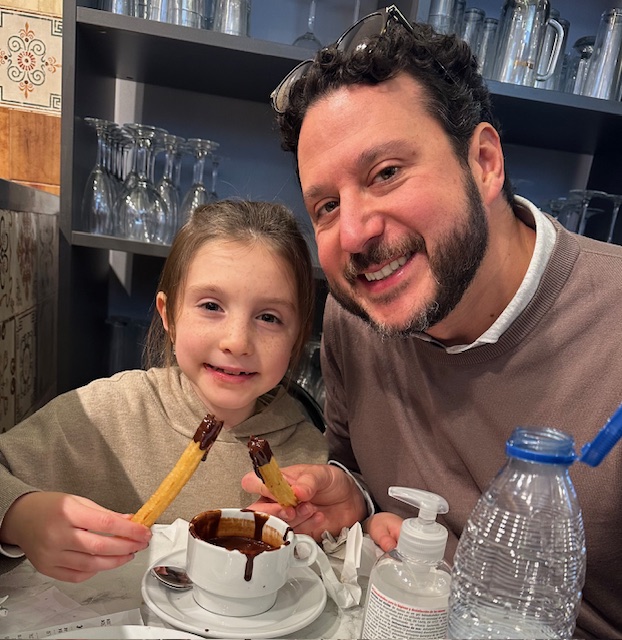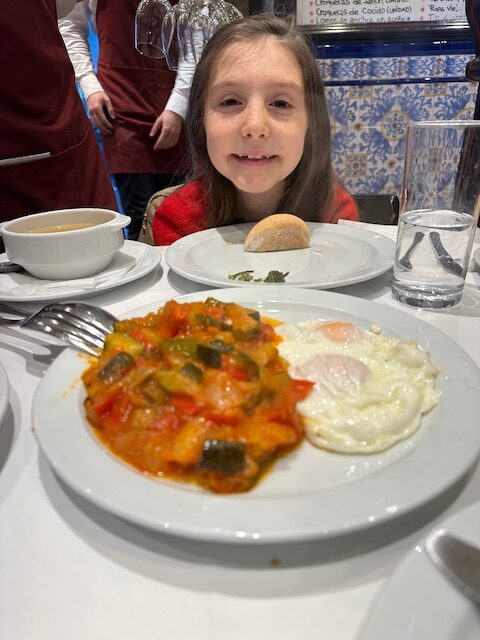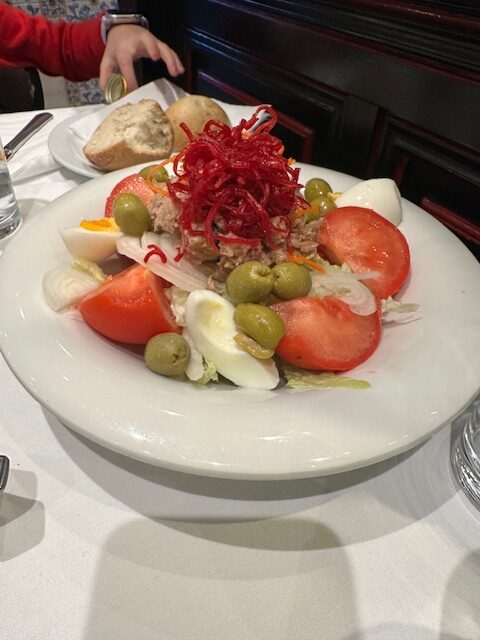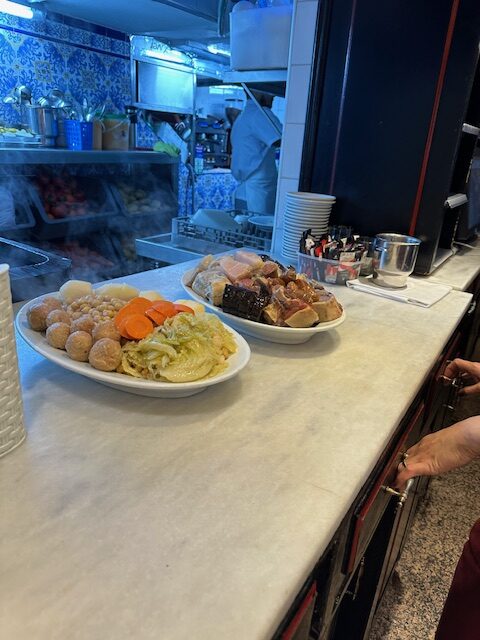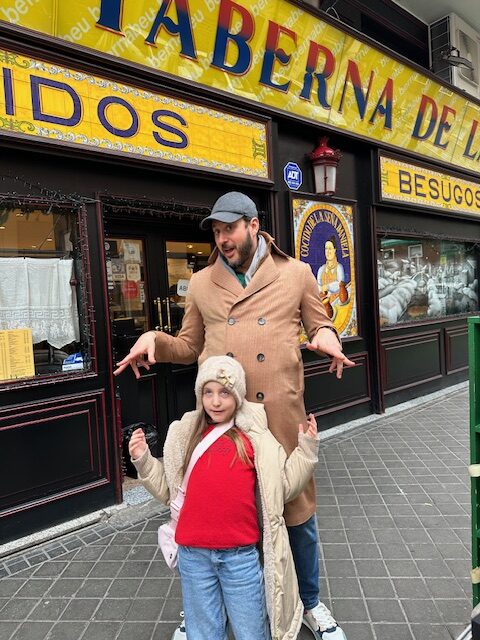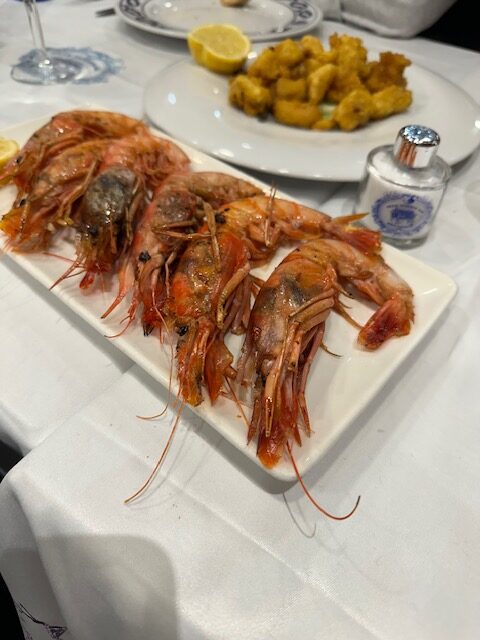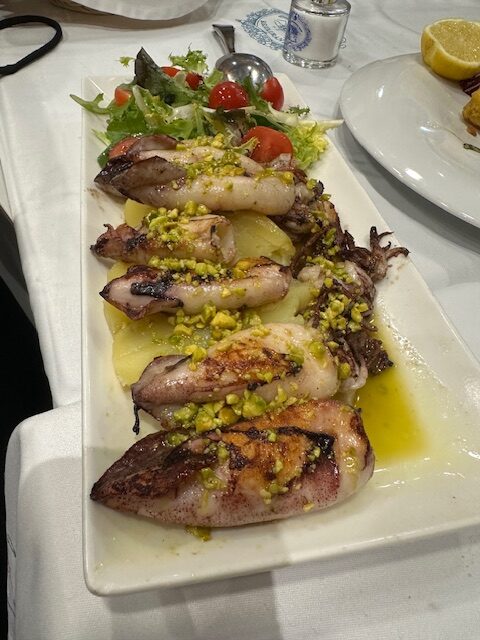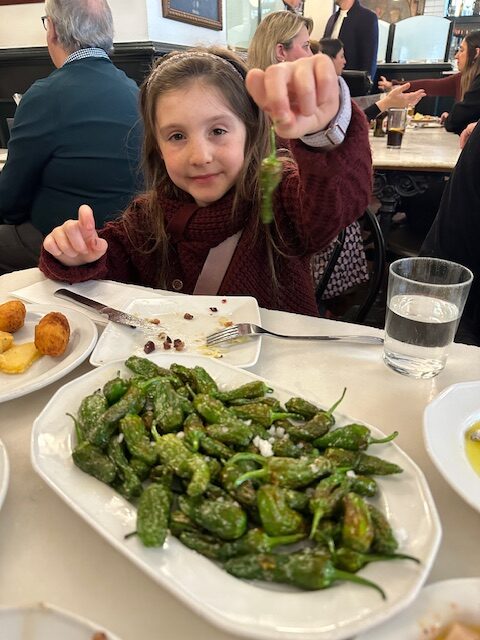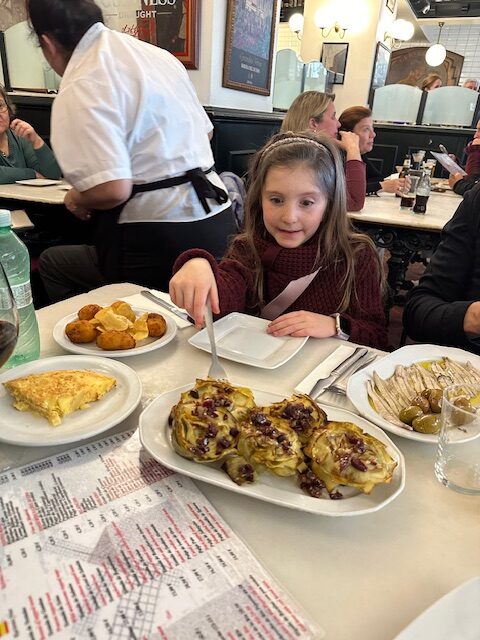I’m not much of a breakfast eater, but if there’s one place that can convince me to forgo my intermittent fasting for a day, it’s Spain.
Traditionally, the Spaniards don’t do bacon and eggs or French toast or yogurt with granola (although you can find pretty much anything you want in most cities these days). Instead, breakfast in Spain is a small affair, either a simple pastry or a small loaf of toasted bread, served with freshly grated tomato, olive oil, and salt.
You can get it at basically any bar in the city. Yes, I said bar. All the tapas bars open in the morning for coffee and barritas de pan con tomate. Alternatively, you can run into any one of the many bakeries situated all over every town. You’ll get the same fare, albeit with a greater array of pastries to choose from.
We typically go to the same bakery every morning in Madrid. It’s called Granier, and it’s located on Calle Hermosilla. I can’t say it’s the world’s greatest bakery. It doesn’t have to be. All we need is a decent croissant for Josephine, good café doble (double espresso), and fresh bread and tomato. It’s wholly satisfying, costs perhaps $10 total for all three of us, and takes approximately 15 minutes.
Now, onto lunch!
Referred to as comida, lunch is the main meal in Spain. I’m not usually the biggest lunch person, but in Spain, we walk a ton, and I’m very hungry by 2:30, a solid lunchtime over there.
On this past trip, I have to say that our lunches were pretty weak. The first day we had in Madrid, Jamil flew to London and back in an attempt to retrieve our bags. Josephine and I had our small breakfast at Granier, thinking Jamil would be back in time for a late lunch, since his plane landed at 2:00. Sadly, when we met him at the airport, we spent another 2+ hours there, trying to locate our bags. So, no lunch for us. Two other days, we had similar issues, wasting hours at the airport, trying to collect our bags. However, there were four noteworthy lunches that I’ll share.
1. El Paraguas – El Paraguas is one of several great restaurants owned by Grupo Paraguas, a popular restaurant holding in Madrid. If you go to the restaurant’s website and scroll to the bottom, you’ll find a listing of the other establishments in Madrid. We’ve tried most of them, and they’re always reliable choices that are super popular with Madrileños.
This year, we ate at El Paraguas for New Year’s Day, a day when I knew the people of Madrid would be having elaborate family comidas. I desperately wanted to avoid the predicament of not having a reservation at an awesome place and having to settle for a lousy substitute. Although we’d never had comida at El Paraguas before, I know the place well enough to feel certain it would be ideal for a leisurely New Year’s Day lunch.
I was totally right. The place was packed. In fact, it was so packed that the only reservation we could get was at 1:00PM, a little early by Madrid standards. However, as it turned out, all the tables in the restaurant were full, and we were the only tourists in the joint. Everyone was there to take their time, drink wine or beer, and indulge in January 1 laziness. We indulged similarly, with me sipping Albariño and Jamil enjoying a caña, as we splurged on a larger lunch than we generally order.
At El Paraguas, the portions are substantial, so although we were tempted to order more dishes, we noted our waiter’s concerned glance and restrained ourselves. We started with jamón because it would be a sin not to. After the jamón, we shared a beautiful tuna tartare and a large mixed salad loaded with avocado, which Josephine devoured.
Then, for our mains, we ordered a couple of things on the heavy side. Jamil and I shared the Fabada Asturiana, a bean stew made with the most delectable white beans, called alubias. They’re buttery but aren’t so cooked that they lose their shape or bite. At El Paraguas, they serve the bean portion of the Fabada in a sparkling white tureen, and another plate holds all the meats – chorizo, morcilla, smoked pork belly – that were cooked along with the beans to infuse them with flavor. It’s a truly Spanish dish – we cannot recreate it in the States. So it’s definitely worth trying, but only if you’re in Asturias (a region in Northern Spain, just west of Cantabria) or at an amazing restaurant, like El Paraguas, that takes the preparation seriously.
While Jamil and I dug into the creamy Fabada, Josephine enjoyed an arroz con pollo, made especially for her. Rice dishes are massive in Spain, rarely made for fewer than two people. Fortunately, the waitress recognized that we could not possibly eat a large rice dish AND fabada, so Josephine received a miniature portion.
I highly recommend El Paraguas. It would be a perfect place for a Sunday lunch, or you can do an evening meal, as we have done several times in the past. Whatever the case, the meal will be special.
2. Cervecería Cervantes – My favorite tapas bar in the entire world? This is it. This is where you’ll get the most authentic environment and food. It’s no-frills, they are not trying to wow you here. They don’t even have a website.
The go-to foods here for me are simple: (1) Ensalada de la Casa – tomatoes, olives, onions, and tons of huge chunks of tuna. Unless you’re with a big salad-eating group, order the portion for one. It isn’t on the menu, but they’ll make it. (2) Pimientos de Padrón – Padrón is a city in Galicia, where they grow these small green peppers, similar to shishitos, but better. Restaurants in Madrid fry them in olive oil and toss them in coarse salt. It’s as plain-Jane and as perfect a preparation as I can imagine, and Josephine eats her weight in them. Eating them is also a fun dart-toss because you never know if you’re going to get a mild one or a super spicy one. (3) Boquerones en vinagre – These are pickled anchovies. They’re not salty like the ones you find on pizza. Instead, they’re sour with vinegar and covered with olive oil. Our family is obsessed with them. (4) Alcachofas a la plancha – The artichokes here are fantastic. They’re served with crispy bits of jamón on top, which provides a nice crunch to contrast with the soft artichoke hearts.
Aside from these dishes, you can order all kinds of tostadas (basically, bruschetta). They have excellent tortilla Española. They have wonderful fried calamari or sauteed shrimp. You can’t go wrong with any of it. Get yourself a rioja or a caña (Spanish word for a tall beer) and just chill. It’s a quick-paced, lively restaurant, so you’re bound to have a blast and leave happy.
3. O’Caldiño — Jamil and I ate at O’Caldiño in 2013, but we went at an odd hour, when the place was dead. This time, it was popping off. The bar was slammed, and the dining room bustled with lively energy. We had to wait probably 10 minutes for a table, but I’m glad we did. We’d never seen the gorgeous dining area in the back of the restaurant before, and it’s quite old-world and refined.
The food is entirely Galician, so it’s seafood-focused, which we were excited about. We ordered fried calamari for Josephine. The fluffy breading was different from the light dusting of cornmeal you often see, and the calamari themselves were small and clearly fresh. No big rings out of a bag here. She also enjoyed our chipirones a la plancha, grilled baby squid, topped with crushed pistachios — very distinctive. And because Josephine was satisfied, Jamil and I risked her wrath and ordered gambas rojas a la plancha, red shrimp grilled whole in their shells. She was not pleased to see us dive headlong into the food she loathes the most, but I can’t lie, it was fantastic.
Word to the wise — those shrimp are expensive!
4. Taberna de la Daniela – When Iberia canceled our flight to Prague out of the blue, we got on the metro to Nuevos Ministerios in search of one last meal in Spain. Nuevos Ministerios is a giant station near Estadio Bernabeu, the home of Real Madrid. It’s an actual neighborhood, filled with Madrileños. I knew we’d find something authentic and good there without much effort.
Taberna de la Daniela is renowned for its Cocido Madrileño, a hefty stew of varied vegetables and meats. It’s the kind of dish you read about but never see produced as it would be in a Spanish home kitchen – kind of how you never really get a roast turkey the same way at a restaurant. I’ve always wanted to try it, and now I know where to do so, although I didn’t get to do so on our visit to La Daniela. It was way too much of a commitment.
They serve the Cocido as three courses. First, they serve the broth with little fideo noodles, setting a huge tureen on each table. Then, they bring out a ginormous platter of vegetables with chickpeas. Finally, a huge tray of various meats arrives.
If you want to come, you definitely need to make a reservation. The restaurant was completely full because people were going bonkers for the Cocido. We got the only available table in the place, and that’s because we were willing to take the only table in the bar, right next to the decaying cigarette vending machine and the trashcan.
We ordered quickly and lightly, knowing we would have to return shortly to the airport to catch the next flight to Prague, but what we had was great. Josephine ordered the Cocido broth, so we got to confirm that the Cocido itself would be fantastic. Then, we got Pimientos de Padrón, of course, and a huge Ensalada Mista, which Josephine loved because it had shredded beets and carrots on top. Last, we ordered Huevos con Pisto. Pisto Manchego combines Josephine’s most beloved ingredients – bell peppers, onions, zucchini, tomatoes – and simmers them into a flavorful stew. Served with an over-easy or sunny-side up egg that you cut and stir into the vegetables, Pisto is a rather healthy dish that’s undeniably delicious. Josephine can eat piles of it, and that day, we actually got two orders!
Next time we go, we’ll be back at La Daniela, hopefully with a group, so we can share that amazing cocido. And if you find yourself near Bernabeu – perhaps checking out a fútbol game – you should make it the place you stop for a meal, especially if it’s a weekend and you can do the cocido.
If you come to Madrid and don’t eat churros con chocolate, you are definitely missing out. Freshly fried, sugared cylindrical pastries, served alongside steaming hot cups of dense, dark chocolate, churros don’t qualify as breakfast, lunch, or dinner. They’re all and none of the above! Madrileños eat them whenever they want a snack, and Josephine thinks they should be a food group all on their own!
Chocolatería San Ginés is Madrid’s most famous spot for churros. It’s over a hundred years old, and over the years, they’ve expanded wildly. There are now multiple spots, all on the same alleyway and all sharing the same kitchen. The original location still has the best old-world vibe, but that line can be the longest. Oh, yeah, the LINE. Expect a wait!!! But rest assured, it moves quickly and is totally worth it!
